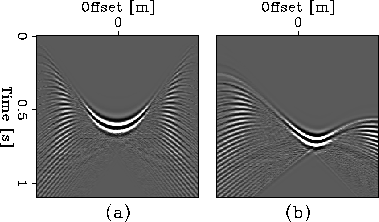




Next: Derivation of the PS-DMO
Up: Dip moveout
Previous: Dip moveout
The kinematics of PS-DMO have been widely discussed in the literature.
Harrison (1990) is the first to derive the zero-offset mapping
equation for converted waves. He uses an
integral-summation approach, similar to Deregowski and Rocca (1981) to
apply DMO to converted-wave data. He also applies the PS zero-offset mapping
and the adjoint of his operator in order to obtain the operator that
describes the cascade of PS-NMO plus PS-DMO, also known as the Rocca's PS
operator. The impulse response for the Rocca's PS operator
is produced by taking an impulse on a constant offset section and
migrating it to produce ellipses. Each element or point along the
ellipses is then diffracted, setting the offset to zero, to produce
hyperbolas Claerbout (1999).
Figure ![[*]](http://sepwww.stanford.edu/latex2html/cross_ref_motif.gif) shows a comparison between the Rocca's smear
operator for single-mode PP data and for converted-mode PS data.
Kinematically, Rocca's operator
for converted waves is both laterally shifted and non-symmetric.
This is an expected result, since the upgoing wave path is slower
than the downgoing wave path, so that the inflection point of the PS impulse response
is at a later time than the PP impulse response. This is because the
S-wave velocity is slower than the P-wave velocity.
shows a comparison between the Rocca's smear
operator for single-mode PP data and for converted-mode PS data.
Kinematically, Rocca's operator
for converted waves is both laterally shifted and non-symmetric.
This is an expected result, since the upgoing wave path is slower
than the downgoing wave path, so that the inflection point of the PS impulse response
is at a later time than the PP impulse response. This is because the
S-wave velocity is slower than the P-wave velocity.
rocca
Figure 5 Rocca's operator, for
single-mode PP data (left) and converted-mode PS data (right)
![[*]](http://sepwww.stanford.edu/latex2html/movie.gif)





This thesis presents a more accurate converted-wave DMO operator.
This operator also accounts for lateral movement of the midpoint location
after doing DMO and follows the amplitude distribution presented
by Jaramillo (1997).
![[*]](http://sepwww.stanford.edu/latex2html/cross_ref_motif.gif) shows a comparison between the Rocca's smear
operator for single-mode PP data and for converted-mode PS data.
Kinematically, Rocca's operator
for converted waves is both laterally shifted and non-symmetric.
This is an expected result, since the upgoing wave path is slower
than the downgoing wave path, so that the inflection point of the PS impulse response
is at a later time than the PP impulse response. This is because the
S-wave velocity is slower than the P-wave velocity.
shows a comparison between the Rocca's smear
operator for single-mode PP data and for converted-mode PS data.
Kinematically, Rocca's operator
for converted waves is both laterally shifted and non-symmetric.
This is an expected result, since the upgoing wave path is slower
than the downgoing wave path, so that the inflection point of the PS impulse response
is at a later time than the PP impulse response. This is because the
S-wave velocity is slower than the P-wave velocity.

![[*]](http://sepwww.stanford.edu/latex2html/movie.gif)